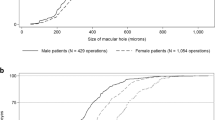Summary
Idiopathic macular holes are today treated surgically with good results. The prognostic value of factors predictive for the anatomical and functional outcome has not been completely evaluated.
Patients and methods: One hundred and thirty-five eyes with penetrating macular holes (stage II–IV) were investigated prospectively. The mean follow-up was 19.5 months (6–50 months).
Results: In 86 % of cases the hole was closed postoperatively. The age of the macular hole proved to be a significantly predictive factor for the outcome; the age of the patient did not. The diameter of the hole showed no influence on the results. Application of autologous serum in front of the hole did not significantly improve the anatomical, but the functional results. The strongest improvement of visual acuity was seen in eyes with poor preoperative function. In 118 eyes a prefoveal membrane could be peeled off. Seventeen eyes without detectable membrane showed identical results.
Conclusion: Some predictive factors in macular hole surgery are proven, others remain uncertain. Identical results in eyes with and without prefoveal membranes support the assumption of different pathomechanisms in macular hole formation.
Zusammenfassung
Idiopathische Makulaforamina können heute erfolgreich operiert werden. Die Bedeutung verschiedener Prognosefaktoren für das Operationsergebnis ist dagegen noch nicht gesichert.
Patienten und Methode: 135 Augen mit Makulaforamina Stadium II–IV nach Gass wurden prospektiv prä- und postoperativ untersucht. Die Nachbeobachtungszeit betrug mindestens 6, im Mittel 19,5 Monate.
Ergebnisse: Nach primärem Eingriff zeigte sich in 86 % der operierten Augen ein Verschluß des Foramens. Das Alter des Makulalochs hatte einen signifikanten Einfluß auf das Ergebnis der Operation, das Alter des Patienten nicht. Die Größe des Foramens beeinflußte weder das anatomische noch das funktionelle Endresultat. Die Applikation von Plasma vor das Makulaforamen verbesserte die anatomischen Resultate nicht, die funktionellen mit geringer Signifikanz. Der postoperative Visusanstieg war bei geringer präoperativer Sehschärfe signifikant stärker als bei gutem Ausgangsvisus. In 118 der 135 Augen konnte eine prämakuläre Membran entfernt werden. Die 17 Augen ohne identifizierbare Membran zeigten die gleichen Ergebnisse.
Schlußfolgerung: Einige Prognosefaktoren erscheinen gesichert, andere bedürfen einer weiteren Abklärung. Die übereinstimmenden Ergebnisse bei Augen mit und ohne epimakuläre Membran sprechen für einen unterschiedlichen Pathomechanismus der Lochgenese.
Similar content being viewed by others
Author information
Authors and Affiliations
Rights and permissions
About this article
Cite this article
Mester, U., Becker, M. Prognosis of macular hole surgery. Ophthalmologe 95, 158–162 (1998). https://doi.org/10.1007/s003470050255
Published:
Issue Date:
DOI: https://doi.org/10.1007/s003470050255




